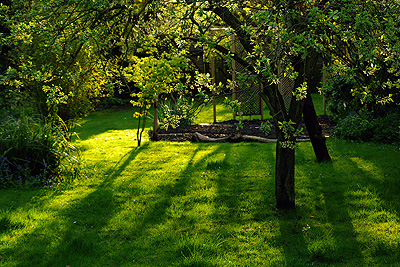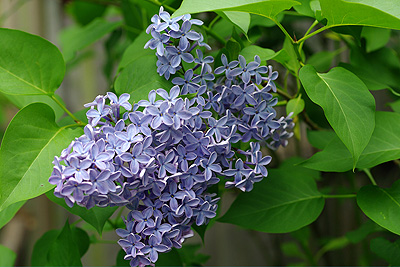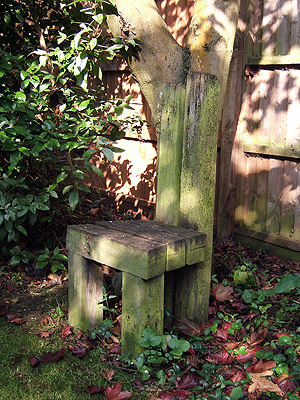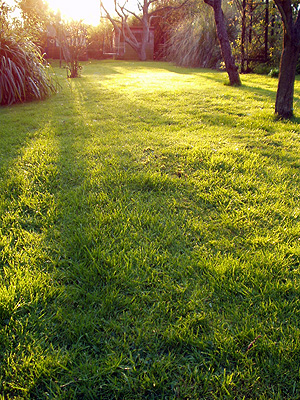The Garden in April - Jobs and Tips
plants for April
Jobs / Tips
![]() Get out and mow the grass as soon as possible
if you haven't done so already (I'm writing this in East
Anglia - England, but it applies to pretty much the whole of
the UK (and much of Europe and North America too). If it's looking
a bit tatty it's because it's started to grow! Set the mower
a bit higher than normal for the first cut and then follow it
up after a few days with a dose of "feed
and weed".
Get out and mow the grass as soon as possible
if you haven't done so already (I'm writing this in East
Anglia - England, but it applies to pretty much the whole of
the UK (and much of Europe and North America too). If it's looking
a bit tatty it's because it's started to grow! Set the mower
a bit higher than normal for the first cut and then follow it
up after a few days with a dose of "feed
and weed".
![]() Look out for weeds and remove them early on.
Weeds are always early risers in the spring and are much
easier to remove while small than when they get larger. It's
a good time to spread a mulch on the bare soil between plants
if you haven't done so already, this also helps keep the weeds
down.
Look out for weeds and remove them early on.
Weeds are always early risers in the spring and are much
easier to remove while small than when they get larger. It's
a good time to spread a mulch on the bare soil between plants
if you haven't done so already, this also helps keep the weeds
down.
![]() Protect young shoots from slugs and snails, scatter
pellets / slug pubs or whatever particularly around clematis
and herbaceous plants (they love Delphiniums). As soon as there
are shoots to eat the slugs and snails will appear from nowhere.
Slug
control
Protect young shoots from slugs and snails, scatter
pellets / slug pubs or whatever particularly around clematis
and herbaceous plants (they love Delphiniums). As soon as there
are shoots to eat the slugs and snails will appear from nowhere.
Slug
control
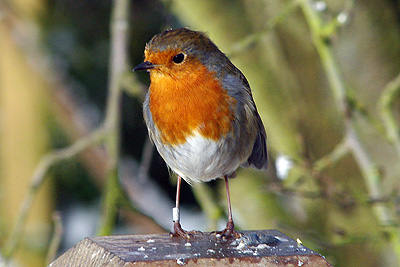
![]() Watch out for early signs of aphids. There will be less
if the winter has been cold, but it's about now that they start
to come out of hiding and build up their numbers. If you can
spot and control aphids early, then life gets an awful lot easier
later on in the year. Check the newly emerging shoots of their
favourite plants. I gave my plants under cover their first spray
last week at the end of March as aphid numbers were already
starting to build up, it's easy to miss them as you probably
don't check so often at the moment.
Watch out for early signs of aphids. There will be less
if the winter has been cold, but it's about now that they start
to come out of hiding and build up their numbers. If you can
spot and control aphids early, then life gets an awful lot easier
later on in the year. Check the newly emerging shoots of their
favourite plants. I gave my plants under cover their first spray
last week at the end of March as aphid numbers were already
starting to build up, it's easy to miss them as you probably
don't check so often at the moment.
![]() Did you sow all of the seeds you intended? March
is the main sowing time for many plants, hardy or half-hardy.
flower seeds,
vegetable seeds
Did you sow all of the seeds you intended? March
is the main sowing time for many plants, hardy or half-hardy.
flower seeds,
vegetable seeds
![]() If you've never tried growing your own vegetables, or grown
anything from seed, then this is a good month to sow. I
tend to go for things that are either expensive in the shops
or difficult to get really fresh.
If you've never tried growing your own vegetables, or grown
anything from seed, then this is a good month to sow. I
tend to go for things that are either expensive in the shops
or difficult to get really fresh.
Beans are easy and don't travel well so the ones in the shops are never as good or fresh as home grown. Broad beans are good as are French beans and very easy too. Dwarf French beans don't need all the long canes that runner beans need, but wait until the end of the month though or early May before sowing them outdoors. They can be started off if you like in 3" pots in an unheated greenhouse.
![]() A "must buy" if you haven't already got any yet are pots of
sweet pea seedlings. They have the advantage over many similar
plants in that they're hardy and so don't need to be kept in
a greenhouse or take up huge amounts of windowsill space. They
benefit from protection though, so keep them under shelter if
you have any, or in a sheltered part of the garden if you don't
until the days start to get warmer.
A "must buy" if you haven't already got any yet are pots of
sweet pea seedlings. They have the advantage over many similar
plants in that they're hardy and so don't need to be kept in
a greenhouse or take up huge amounts of windowsill space. They
benefit from protection though, so keep them under shelter if
you have any, or in a sheltered part of the garden if you don't
until the days start to get warmer.
![]() Lift and divide summer flowering perennials.
Pull them apart gently but firmly so that the plant divides
at its weakest point/s, don't be tempted to cut.
Lift and divide summer flowering perennials.
Pull them apart gently but firmly so that the plant divides
at its weakest point/s, don't be tempted to cut.
![]() Take time to enjoy your garden and smell the
flowers - as I sat down at my computer to write this page
I was sidetracked by my 5 month old puppy wanting to go out,
so I went into the garden with her and the older dog and a mug
of tea.
Take time to enjoy your garden and smell the
flowers - as I sat down at my computer to write this page
I was sidetracked by my 5 month old puppy wanting to go out,
so I went into the garden with her and the older dog and a mug
of tea.
I ended up sitting for about an hour on a rustic chair I've made from old oak fence-posts in the sun under the plum tree that is starting to come out in blossom. There was constant bird song, Brimstone and Red Admiral butterflies and honey bees that the sun had woken up were flying about. The dogs were playing and little one would run up my outstretched legs every now and then for reassurance and a big fuss. There were daffodils, Forsythia, primroses and the scent of hyacinths, the whole garden was in puppy-mode in fact. Make sure you take the time to enjoy your garden.
![]() If you've any rotted garden compost that's ready
to use, this is a good time to place it around the more mature
garden plants and trees as a thick mulch. I use up
to about half a barrow-load each around young trees and large
shrubs. It looks a bit odd at first with brown mounds at the
bottom of the trunk, but it soon gets mixed in by the worms
and continues to rot and improve the soil. The effect is not
immediate, but within a year or two, it's quite noticeable,
the improvement in soil texture and the slow-release fertiliser
effect it has will boost anything you place it around. Just
be careful not to bury small plants with it, or put it where
you plan to plant bedding plants over the next couple of months
or so - it will help them too, it's just that garden compost
tends to be rather too coarsely textured for small plants to
cope with easily.
If you've any rotted garden compost that's ready
to use, this is a good time to place it around the more mature
garden plants and trees as a thick mulch. I use up
to about half a barrow-load each around young trees and large
shrubs. It looks a bit odd at first with brown mounds at the
bottom of the trunk, but it soon gets mixed in by the worms
and continues to rot and improve the soil. The effect is not
immediate, but within a year or two, it's quite noticeable,
the improvement in soil texture and the slow-release fertiliser
effect it has will boost anything you place it around. Just
be careful not to bury small plants with it, or put it where
you plan to plant bedding plants over the next couple of months
or so - it will help them too, it's just that garden compost
tends to be rather too coarsely textured for small plants to
cope with easily.
Copyright 2000 - present. All Rights Reserved | Privacy Policy Statement

